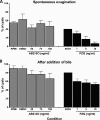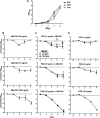Sensitive in vitro system to assess morphological and biochemical effects of praziquantel and albendazole on Taenia solium cysts
- PMID: 21041508
- PMCID: PMC3019660
- DOI: 10.1128/AAC.00761-10
Sensitive in vitro system to assess morphological and biochemical effects of praziquantel and albendazole on Taenia solium cysts
Abstract
Neurocysticercosis resulting from Taenia solium infections is a major cause of adult-acquired seizures worldwide. Disease is caused by larval cysts, and treatment consists of the anthelmintic drugs albendazole or praziquantel. There are no standard methods to assess drug activity to T. solium cysts in vitro. Morphological, functional, and biochemical changes that might reflect damaging (inhibiting, cytotoxic) drug effects were analyzed after exposure of cysts to albendazole sulfoxide (ABZ-SO), the major active metabolite of the drug in vivo, praziquantel (PZQ), or combinations of both. PZQ exposure led to a decrease in cyst size and inhibition of evagination, whereas ABZ-SO exposure resulted in minimal changes. Alkaline phosphatase (AP) is normally secreted by cysts, and both drugs inhibited AP secretion at concentrations of 5 and 50 ng/ml for PZQ and ABZ-SO, respectively. Some combinations of both drugs resulted in additive and/or synergistic activities. Parasite-specific antigen, detected in the cerebrospinal fluid and blood of infected patients, is also normally secreted by T. solium cysts. Antigen secretion was similarly inhibited by ABZ-SO and PZQ and a combination of both drugs, suggesting that inhibition of secretion is a common downstream consequence of the activities of both drugs. These studies establish quantitative methods to measure in vitro anthelmintic activity and suggest combination therapy with ABZ-SO and PZQ may have clinical benefit.
Figures





Similar articles
-
In vitro effects of albendazole sulfoxide and praziquantel against Taenia solium and Taenia crassiceps cysts.Antimicrob Agents Chemother. 2004 Jun;48(6):2302-4. doi: 10.1128/AAC.48.6.2302-2304.2004. Antimicrob Agents Chemother. 2004. PMID: 15155240 Free PMC article.
-
Cysticidal Efficacy of Combined Treatment With Praziquantel and Albendazole for Parenchymal Brain Cysticercosis.Clin Infect Dis. 2016 Jun 1;62(11):1375-9. doi: 10.1093/cid/ciw134. Epub 2016 Mar 16. Clin Infect Dis. 2016. PMID: 26984901 Free PMC article. Clinical Trial.
-
In vitro analysis of albendazole sulfoxide enantiomers shows that (+)-(R)-albendazole sulfoxide is the active enantiomer against Taenia solium.Antimicrob Agents Chemother. 2013 Feb;57(2):944-9. doi: 10.1128/AAC.01465-12. Epub 2012 Dec 10. Antimicrob Agents Chemother. 2013. PMID: 23229490 Free PMC article.
-
Intra-cystic concentrations of albendazole-sulphoxide in human cystic echinococcosis: a systematic review and analysis of individual patient data.Parasitol Res. 2016 Aug;115(8):2995-3001. doi: 10.1007/s00436-016-5054-x. Epub 2016 Apr 16. Parasitol Res. 2016. PMID: 27085708 Free PMC article.
-
Routine drug and food interactions during antihelminthic treatment of neurocysticercosis: a reason for the variable efficacy of albendazole and praziquantel?J Clin Pharmacol. 2014 Apr;54(4):361-7. doi: 10.1002/jcph.269. Epub 2014 Jan 25. J Clin Pharmacol. 2014. PMID: 24443292 Review.
Cited by
-
Microsurgical Treatment of Epilepsy with Parenchymal Neurocysticercosis.Curr Med Sci. 2019 Dec;39(6):984-989. doi: 10.1007/s11596-019-2132-1. Epub 2019 Dec 16. Curr Med Sci. 2019. PMID: 31845231
-
Neurocysticercosis-more than a neglected disease.PLoS Negl Trop Dis. 2013 Apr 25;7(4):e1964. doi: 10.1371/journal.pntd.0001964. Print 2013. PLoS Negl Trop Dis. 2013. PMID: 23638190 Free PMC article. No abstract available.
-
Quantitative screening for anticestode drugs based on changes in baseline enzyme secretion by Taenia crassiceps.Antimicrob Agents Chemother. 2013 Feb;57(2):990-5. doi: 10.1128/AAC.01022-12. Epub 2012 Dec 10. Antimicrob Agents Chemother. 2013. PMID: 23229489 Free PMC article.
-
Experimental porcine cysticercosis using infected beetles with Taenia solium eggs.Acta Trop. 2018 Jul;183:92-94. doi: 10.1016/j.actatropica.2018.04.003. Epub 2018 Apr 4. Acta Trop. 2018. PMID: 29626435 Free PMC article.
-
Case Report: Ivermectin and Albendazole Plasma Concentrations in a Patient with Disseminated Strongyloidiasis on Extracorporeal Membrane Oxygenation and Continuous Renal Replacement Therapy.Am J Trop Med Hyg. 2018 Nov;99(5):1194-1197. doi: 10.4269/ajtmh.18-0487. Am J Trop Med Hyg. 2018. PMID: 30226142 Free PMC article.
References
-
- Brandt, J. R., S. Geerts, R. De Deken, V. Kumar, F. Ceulemans, L. Brijs, and N. Falla. 1992. A monoclonal antibody-based ELISA for the detection of circulating excretory-secretory antigens in Taenia saginata cysticercosis. Int. J. Parasitol. 22:471-477. - PubMed
-
- Cobo, F., C. Yarnoz, B. Sesma, P. Fraile, M. Aizcorbe, R. Trujillo, A. Diaz-de-Liano, and M. A. Ciga. 1998. Albendazole plus praziquantel versus albendazole alone as a pre-operative treatment in intra-abdominal hydatisosis caused by Echinococcus granulosus. Trop. Med. Int. Health 3:462-466. - PubMed
-
- Escobedo, G., M. C. Romano, and J. Morales-Montor. 2009. Differential in vitro effects of insulin on Taenia crassiceps and Taenia solium cysticerci. J. Helminthol. 83:403-412. - PubMed
-
- Garcia, H. H., and O. H. Del Brutto. 2005. Neurocysticercosis: updated concepts about an old disease. Lancet Neurol. 4:653-661. - PubMed
-
- García, H. H., R. H. Gilman, A. E. Gonzalez, M. Verastegui, S. Rodriguez, C. Gavidia, V. C. W. Tsang, N. Falcon, A. G. Lescano, L. H. Moulton, T. Bernal, M. Tovar, and The Cysticercosis Working Group in Peru. 2003. Hyperendemic human and porcine Taenia solium infection in Peru. Am. J. Trop. Med. Hyg. 68:268-275. - PubMed
Publication types
MeSH terms
Substances
Grants and funding
LinkOut - more resources
Full Text Sources

